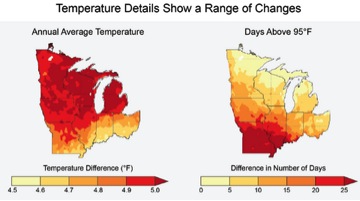Climate Change Adaptation Planning for Great Lakes Parks
Addressing the potential impacts of climate change on lands in the National Park System (NPS) is one of the highest priorities in the NPS. Forested parks, like Voyageurs, near the current prairie-forest border could be transformed to open savanna in the next century. Boreal plant and animal species would be lost or become very rare within each park, persisting only in areas where cool conditions exist such as north-facing slopes or moist gullies. Species that might disappear include at least ten boreal tree species that are currently the backbone species for ecosystem function, including common species such as quaking aspen, balsam fir, black ash, white cedar, and red pine. There will also be changes in bird and mammal communities, with the range of most species shifting northward. The result will be a new mixture of species in the park, with some northern species no longer present (for example, boreal chickadees) and replaced by more southerly species (for example, northern cardinals). A new project was started in 2013 to provide information to the Great Lakes park managers to better understand potential changes to forest communities over the next 50 to 100 years as well as the birds and mammals that rely on them. The project’s first phase is to use climate models to predict temperature and precipitation patterns for the region surrounding Voyageurs and 6 other forested parks in the Great Lakes region. These “downscaled” climate models will next be used to predict the presence of trees, wildflowers, birds, and mammals in 2040, 2070, and 2100 based on known tolerances of these species to temperature and precipitation.
The project will also seek to improve how the NPS and its park partners communicate the implications of climate change to park staff, visitors, and the general public. The project team will accomplish this through a series of outreach that includes workshops aimed at different interest groups. The first workshop is scheduled for late July 2014 at Voyageurs National Park.

